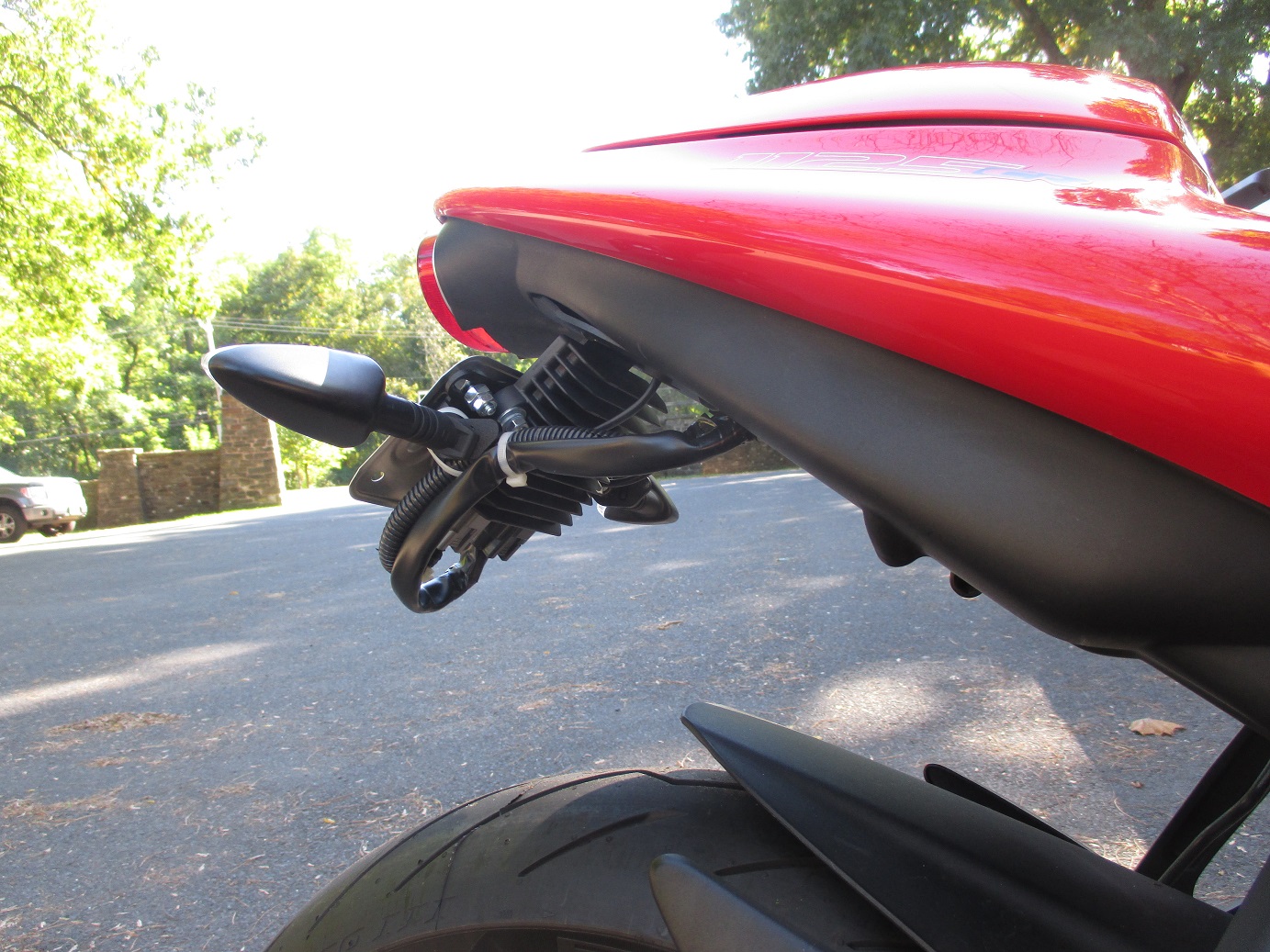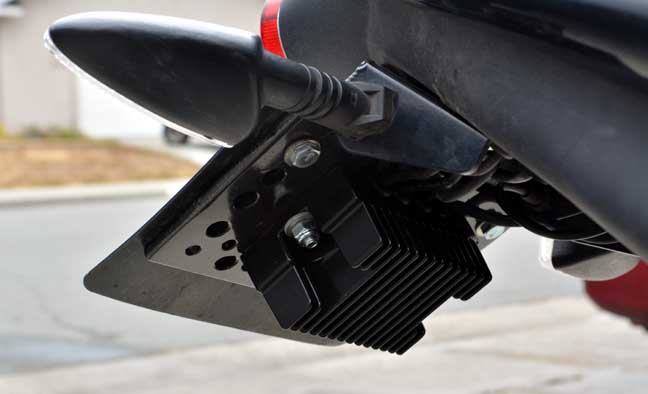| Author | Message | ||
Jmoreno88 |
So I've installed the sh847 on my CR. Right now it is located in the original spot as the factory so it gets some airflow but not tons. I see most install right behind the license plate. Is this very beneficial or can I leave it where it's at? From my understanding they get pretty warm to the touch either way | ||
Joe7bros |
I mounted mine behind the plate; better airflow. I also swapped out the original license plate mount with an aluminum tail tidy  | ||
Stevel |
The series regulator is not required to waste excess current to effect regulation. It regulates by switching the stator output on and off varying the duty cycle of the stator coils, so it doesn't get near as warm. | ||
Panshovevo |
I just bought one for my CR, but things have gotten in the way of mounting it. I believe Jack @roadster cycles recommends mounting them in good airflow, but need to read the directions again. | ||
Joe7bros |
Steve, I think that's backwards, series regulators allow the stator to operate at full output and the regulator sheds the excess energy as heat, shunt types "shunt" the excess back to the stator, and the stator sheds the excess energy as heat, which is why the 1125s burn up stators unless they have additional oil to provide cooling; the Harley "fix" shuts down one phase of the stator. | ||
Joe7bros |
Panshovevo, also purchased mine from Jack; good guy with a good product. | ||
Jmoreno88 |
Thanks for the tips. Spoke with Jack and he does recommend mounting in air if possible so looks like I'll mount behind the plate like the photo above | ||
Terrys1980 |
Steve is correct. A shunt type, shunts the voltage which puts extra load on the stator causing heat. The stator puts out full load no matter what regulator is on it. It has no way to know. The reason for the failures was they upped the output current in the 09+ and didn't have sufficient cooling. | ||
Joe7bros |
Terry, isn't that what I said, essentially; other than the comment about the 09s and 10s | ||
Terrys1980 |
Technically no, because the voltage is shunted to ground and not back to the stator. Basically creating a safe ground fault. | ||
Duanelr |
I'm going to say it and I'll apologize in advance... Those cables hanging down like that, fsck that's ugly. | ||
Jmoreno88 |
I really wasn't liking the license plate area for mine. Took out the factory mount plate to open it up and turned the fins outward so the air blows over them. Fits fine and doesnt get any hotter than the license plate mount so ill probably just leave it here. | ||
Coastrambler |
The alternator (stator + rotor & VR} deliver only what the load draws. In the case of a shunt type VR the stator is called on to deliver its full capability at all times. The energy not needed to operate the bike goes to ground as heat. In the series VR only the needed amount of energy is drawn. A series VR runs much cooler as does the stator. Am attaching a photo of my VR mount.  | ||
Jmoreno88 |
Looks good but that VR looks much smaller than the 847 so it looks cleaner there than the 847 does | ||
Stevel |
Joe, I think your understanding of a VR needs a little help. Motorcycle alternators are different than automotive alternators because they use rotating permanent magnets, where automotive alternators use an electric coil in the rotating stator. Automotive regulators vary the excitation current and thusly the strength of the rotating magnetic field. This controls the alternator output.Motorcycle alternators cannot be controlled this way because the excitation field is always present at maximum strength. The laws of thermodynamics state that energy created and not consumed as work always results in waste heat. The waste heat of the alternator system will be shared by all the components from the stator coils to the internal components of the VR. The difference between a series VR and a shunt (parallel) VR is that the shunt VR dumps the unused current to ground through varying resistance transistors and a series VR switches the coil outputs on and off rapidly allowing only the current required to support the required load thereby reducing the amount of waste heat generated as well the mechanical energy from the crankshaft required by the alternator allowing more power to be delivered to the rear wheel. The fixes provided by both HD and EBR are really Band Aids that addresses the effects of the problem, as opposed to the root cause. The EBR fix is especially dangerous because it bleeds oil from the crankshaft at the expense of the valve train, which really benefits from better available oil flow. | ||
Ratbuell |
I'm going to take issue with the above description because (first of all) there is no such thing as a "rotating stator"...it's a "rotor". And, motorcycle stators have varied output just like an automobile does, it is varied by RPM. Faster spinning = higher voltage output. Perform the stator test as described in the shop manual, and you'll see it is a fairly direct correlation between RPM and V, between idle and the point where the stator reaches its max output (which is determined by the physical wrapping on the coil, and the size of the magnets). RPM is the ONLY way to vary the output of an alternator system (whether spinning coil like an auto, or spinning magnets like a Buell). The size of the magnets and the windings in the coil, are what determines maximum output. RPM variance only exists until the design reaches its full output at whatever RPM is in the unit's particular specifications; once it hits that RPM, the output is constant. An automotive system is the same as the motorcycle system, only "inside-out", spinning the coil instead of spinning the magnets. And because size is not as much an issue on a car, there is a regulator built into the alternator housing itself which changes the V from AC to DC before it leaves the housing. There is still a DC regulator built into the auto's chassis electronics, sort of like a "power conditioner" if you will, but it does not convert like the Buell VR's do (again, perform the output test per the shop manual and you will see the voltage variance until max is reached, and you will note that stator output is AC). All of that said...my 09 CR has about 10k miles on it (I bought it new). I lost the original stator at 2.5k miles and had it replaced along with adding the relay harness. Since then, I have had zero problems with the charging system, but I ride the bike over 4000 rpm which keeps oil circulating and cooling the stator. I am considering relocating the VR for airflow, or simply putting some ductwork into the undertail. A note for those who move the factory VR - YOU HAVE TO REPLACE THAT "GOOK". The white stuff that looks like grease, between the VR's baseplate and the frame of the motorcycle, is exactly that - HEAT SINK GREASE. It is designed to help conduct the heat from the VR's baseplate/heat sink, into the (larger thus more "efficient" at dissipating heat) motorcycle's subframe. Do NOT move the factory VR without a) mounting it to metal and b) making sure you have a good coating of heat sink paste between the VR and the frame. | ||
Stevel |
Joe, My mistake on the rotating stator. It should have read rotating element. You are not correct on your RPM statement. Maximum output current is always limited by magnetic saturation of the stator coils. Of course you are correct to assume that speed of rotation is an element of total power out, but it is saturation that is the power limiter. Google is your friend here. As far as system function differences, I am correct. Think average power. The automotive alternator uses varying rotor excitation for system control and because this is not possible with rotating permanent magnets, the stator coils will always work at 100%, if continuously connected to the rectifiers. A shunt VR will then dump the excess energy above system requirements to ground via bypass transistors. The series regulator uses duty cycle control by switching the stator coil to rectifier connection on and off, limiting the AVERAGE current out to match system requirements. So the logic is that if you don't make excess power, you don't have waste it as heat and if you don't make the heat, you don't have to dissipate it. Again, the series regulator addresses the cause and the shunt regulator and all the other fixes address only the effects. (Message edited by steve-l on May 21, 2017) |